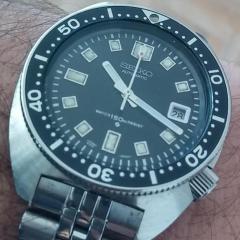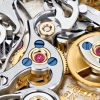Leaderboard
Popular Content
Showing content with the highest reputation on 03/01/19 in all areas
-
Perhaps the "older" WRT-members remember that I, as a watch-novice (which I still am) back in begin 2016 serviced my own Rolex Submariner (3135). After putting myself through a rigorous training on two ETA 2540 / 2541, 17mm ladies watches, the Rolex 3135 was next. That caused, rightly, some stir on the forum. Before the service I build Stefans Watch-O-Scope to test the end results and to do some adjustments if required. With the excellent video of Mark, servicing a 3135, I performed the service. There were some heart-stopping moments, especially when at the end, while adjusting the daily-rate with a Microstella tool, my right-hand holding the balance-wheel with tweezers started doing his own thing and I bend the hairspring at the stud. Luckily that I could fix......... After the service the Watch-O-Scope signal looked horrible. The beat-error was in different position all over the place. We had endless discussions on the forum about what to do and what was next. Despite the poor W.O.S results, the Rolex ran constantly +2 or +3 seconds a day. Other attempts on the Watch-O-Scope proofed futile and for a long time I've been thinking about admitting defeat and to get the Rolex fixed by an official Rolex service point. That was until today. Even through I was quite happy with the W.O.S. results on all my other watches, I decided (after repairing a heirloom pocket-watch and the owner donated me some extra) to buy the Chinese Weishi 1000 timegrapher. Knowing how the Rolex raw-data looked like on the W.O.S. screen, I didn't expect the Weishi 1000, which came today, to make much sense out of it either. The proof is in the pudding they say, so one of the first watches to test was my Rolex. To my surprise the Weishi 1000 picked the 28800 bpm signal correctly and without any problems up. Even better, and to my big relieve !, the Rolex runs actually quite good. I hadn't worn the Rolex for a least two weeks, so it was cold and had to be hand wound. Lift angle set at 52 degrees. Dial Up: -7 s/d, 294 degrees, 0.1 ms Dial down: -7 s/d, 292 degrees, 0.0 ms Crown down: -3 s/d, 272 degrees, 0.0 ms Crown up: -2 s/d, 278 degrees, 0.2 ms. I know that when worn, the Rolex runs +2 to +3 s/d constantly. This get to show, as @JohnR725 keeps saying with timegrapher signals; Rubbish in = Rubbish out. To my big relieve it also shows that I didn't ruin my Rolex and that it actually runs very fine....... no need for a new balance staff or an official Rolex service, saving me at least a $1000 and giving me a peace of mind. I've been very happy with the W.O.S and it still has its place. The Weishi 1000 however ....... It thoroughly impresses me ! I like to thank everybody for their input a few years back and just in case there were still some members out there wondering & worrying about my novice Rolex "endeavor", we can now put this aside and all sleep well Cheers: Roland.1 point
-
1 point
-
What I heard (60 years ago....) They threaded it and screwed on a nut. At one time the story involved The Americans and the Swiss. Had to be true at some point1 point
-
Hi AndyHull , your enthusiasm is to be commended . That is how I , and I am sure many others on this forum , got started with this addiction . I started by getting a bag of cheap watches and parts from India to make steampunk jewelry from the watch parts . Then after I saw a couple of watches in that bag trying to run I decided to try and take one apart and see if I could re-assemble it to run again . After 3 or 4 attempts full of parts pinging off to the Moon , and stretching out of shape a couple of hairsprings , I succeeded ....and was hooked . Riding the wave of my success , I graduated to Inexpensive Timex watches to collect and operate on . Hand wind , automatics , electrics , and any thing else they produced to throw my pennies at . Then very slowly , but with consistency , came the Seiko and Citizens , Then the Invictas , then the other American brands followed by the vintage Swiss watches , then the more affordable more contemporary Swiss watches . I can always find or make up justification to get my next watch . Now I have addicted to Longines , Breitling , Omega , and Rolexes ....whew .......Watch Your Step .....and enjoy your path wherever it takes you . I think Jersy Mo can steer you in a direction for things Timex ....Good Luck .1 point
-
I use Rodico if i can't get it of . But once in a while it won't come of i use some tape and that usually works. It's stickier the Rodico .1 point
-
You will need access to the keyless side to see what is wrong. This requires the movement to be removed from the case and then the hands & dial to be removed.1 point
-
Had to make a balance staff for an Elgin 16S Pocket watch. Used the old on as a sample and cut 90% of the staff without flipping it around. The pivots were 0.12mm and I needed to use the Jacot tool to remove material from the pivots for the final fit. As well, I shaved too much material off the hairspring side and needed to reduce the size of the collet with my staking set. Also needed to adjust the hairspring as it moved when I compressed the hairspring. Photos and video(hairspring collet reduction) Sent from my iPhone using Tapatalk Pro1 point
-
Greetings all. I'm in the process of attempting to replace a roller jewel in a extra-thin Illinois pocket watch, 12s+ grade 439, IIRC. There is very little space to get the jaws of the combination tool onto the roller table to hold and heat it up. I have the hole cleaned out, and even if I do get a tool on it there will be trouble getting shellac on the top of it to start the process. Since I'm pretty sure that the pocket watch combo tools that I have wouldn't work on wrist watches, what do you guys use for this purpose? Do you just replace the whole assembly, table and all? Thanks ahead of time. Cheers. I'll try to post images a bit later. Thanks again.1 point
-
In case the stone dosn,t come off, I drop the whole jewels assembly in a jar add little lighter fluid or any fluid in which oil disloves, close the lid and rotate the jar to get the fluid circle few turns around, the cab comes off from chaton. I use dark color jars( ladies makeup jars) which lets me see the cab in contrast. In extreme case of a real stubburn end stone, I use balance with one broken pivot. Insert the good pivot through the holes of chaton and that of the jewel, flip over to place the end stone on cardboard, press the pivot to push the end stone out and released from chaton.1 point
-
Thanks for the suggestions. I have picked up some 9010 and this thread has helped me plan a way forward. I will get a timegrapher but when I have maybe ten watches that I have cleaned and actually run for a day, I will set about the more detailed work. At the moment it is still proving a challenge to get watches running freely. I partly wish just out of interest I had kept a running tally of expenses but then again maybe not.1 point
-
No cleaning at all !!!?? Refer to my incomplete thread titled" tips on safe removal cleaning installation of fidly cab stones To clean end stone's flat surface, place a piece of cardboard or thick paper with honey comb rough surface on a flat anvil or flat surface, place end stone flat surface on top of the paper, pour some lighter fluid on paper, hold cab stone down with finger and rub the stone on wet surface, press down on stone as hard as you like, you will be surprised how shiny the flat surface of stone turns out. Some tiny pieces of the cardboard aggregates around the stone which may not be visible at regulare magnification, to rinse that off , drop the stone in lighter fluid, remove stone with a clean tea spoon or tools you like.ready to be oiled. Pegging the holes in jewels is beyound1 point
-
This is the hallmark of seiko, day date jump stuck half way for the whole day and good part of yesterady and the rest of tommorow. Service may help. I have seen some with day date disconnected just to have something that runs.1 point
-
Could be a few things. Is it stiff when changing the time if so it's the cannon pinion too tight. The day or date wheels are buckled or more likely the the date drive wheel or day finger is bent and catching.1 point
-
I would put your 7750 aside and take some cheaper o watches and practice in them first, balances can be tricky, however only way to learn is to practice. Was a few years before I started on 7750s1 point
-
Fascinating and inspiring as usual. I trying not to get inspired too much.1 point
-
1 point
-
The staff should be a Howard #560, providing it is a friction-fit staff. Otherwise it might be a 561, which appears to be riveted. The dimensions for the #560 should be 4.00L/.45mm hairspring shoulder/.50--.76mm for two-piece double roller/.10 mm pivot. Let me know if you need dimensions for the riveted style. Good luck.1 point
-
Yes the part you have circled is the regulator arm and if the watch is running slow you need to move it toward the + this will move the regulating pin and in effect shorten the hairspring making the watch run faster. You should be very careful and gentle when doing this, I would be tempted to move it directly to the centre position because it has already be adjusted to run slower. Has your watch been running accurately up to now ? it may be time to service the movement. A watch timing machine greatly assists any adjustment of this type.1 point
-
1 point






